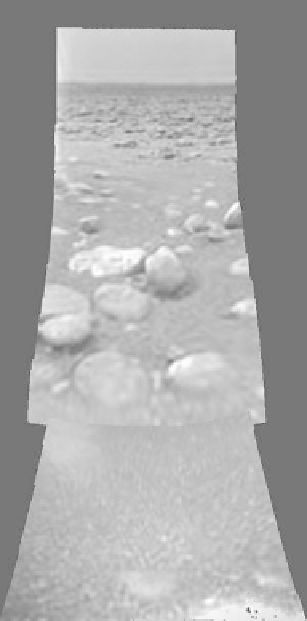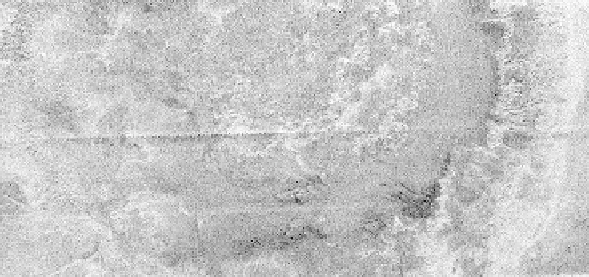Geology Reference
In-Depth Information
ice, an ammonia-rich water ocean, and an outer solid shell
consisting of organic materials and ices. Interior heating
from radiogenic sources in the core, coupled with tidal
heating, could lead to tectonic and volcanic processes. For
example, the ridges shown in
Fig. 9.9
are likely to be tilted
blocks of crust lifted by faulting. They occur in the moun-
tainous region of Xanadu and are similar to features seen
west of Shangri-La. In both regions, ridge belts are ori-
ented east
-
west and are spaced about 50 km apart, sug-
gesting tectonic compression in the north
-
south direction.
Various possible cryovolcanic features were imaged by
Cassini, but the image quality is rather low. These include
numerous lobate
flows, small domes, and putative calde-
ras. Some of the
flows, such as Ara Fluctus, appear to
originate in calderas.
Figure 9.10
shows a possible cal-
dera about 100 km across in the southern hemisphere.
Although it could be a modi
ed impact basin, it lacks
raised rims and is rather irregular in plan-form.
Figure 9.6. The Huygens camera returned these images from its
landing site, viewed toward the horizon. The cobbles in the
foreground are 10
Figure 9.7. A Cassini radar image of Titan
s crater, the 30 km in
diameter Ksa, showing its raised rim, central peak, smooth
oor, and
extended ejecta deposit. Ksa is in the terrain between the Xanadu
and Fensal regions; the dark band across the image is a radar artifact
(NASA PIA08737).
'
15 cm across and are thought to be composed of
ice; their rounded appearance is attributed to erosion by a
uid, such
as liquid methane (NASA PIA06440).
-
Figure 9.8. The multi-ring impact structure, Menrva, has
an outer rim diameter of 440 km, shown on this Cassini
radar image mosaic; the horizontal bands are mosaic
artifacts (NASA PIA07365).





